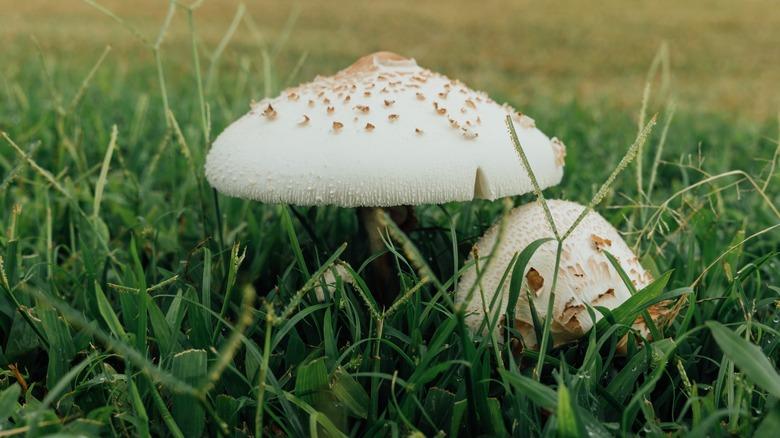How To Get Rid Of Mushrooms
The mushrooms you see are the fruiting body of a hidden, microscopic organism called a mycelium, and removing visible mushrooms is somewhat like picking apples from a tree. Mycelia are hardy — so hardy that they can sprout in space. If you don't want mushrooms to grow in a particular place, you should do something about the mycelium, but that's difficult to do, because mycelia can grow very large. In fact, the largest organism in the world is a mycelium that sprouts armillaria ostoyae mushrooms in the forests of eastern Oregon. While destroying an entire mycelium system may not be practical, there are ways to prevent one from sprouting mushrooms in a particular spot, such as your lawn or a musty closet.
Mushrooms on the Lawn
Mushrooms on the Lawn
When left alone, mushrooms are seldom harmful, and they can even be an attractive addition to your landscape. Their presence usually indicates fertile soil, so you're more likely to see them in a healthy lawn than in one with patchy areas and yellow grass. Because a number of species are toxic, however, wild mushrooms can be a concern when children or pets are around; in those cases, removing them is the wise thing to do.
Mushrooms need two things to grow: moisture and shade. They are most likely to sprout in early spring, when the ground is wet and the air is cool. If you see them on your lawn in summer, it could mean you are overwatering. Reduce the frequency and length of watering, and, if you have a drainage problem, correct it by digging drains. Trimming back overhanging branches to bring sunlight to the areas in which you see them also helps.
You can always remove mushrooms by picking them, although if you don't recognize the species, you should wear gloves when doing this. You can also spray visible mushrooms with a solution consisting of 1 part white vinegar to 4 parts water. This will kill them, and you can simply wait for the dried mushrooms to decompose.
A third option is to spray them with a commercial fungicide, which may have an effect on the mycelium. You can disrupt the mycelium even more by aerating the ground around the places where mushrooms grow and adding high-nitrogen fertilizer. The fertilizer hastens the decomposition of the organic matter on which the mycelium feeds. You need a fast-release mixture, not a time-release one. Spread it at a rate of 1 pound of actual nitrogen per 1,000 square feet of lawn.
Mushrooms in the House
Mushrooms in the House
Mushrooms growing indoors present a classic sign of a moisture problem. It may be from a plumbing leak, a roof leak or a severe lack of ventilation. Correcting the moisture problem is the first step in the eradication procedure.
Whenever you see mushrooms growing from floorboards, exposed framing or some other indoor surface, you can be fairly certain there is also mold there. It will often be visible as a blackened area around the actual mushrooms. When you've eliminated the moisture problem, this mold will go dormant, as will the mycelium that has also become established. It's still important to physically remove the mushrooms and mold.
You can kill visible mushrooms and mold by spraying them with a bleach solution, but because bleach has a high surface tension, it won't penetrate porous surfaces, such as wood, and kill the spores inside. Instead of bleach, the EPA recommends removing mold by scrubbing with detergent and water. This treatment will also remove mycelia clinging to the surface. After scrubbing, treat the area with a borate-based fungus killer. Unlike bleach, borates will penetrate porous surfaces and kill spores deep within. They also prevent more spores from getting established there.
